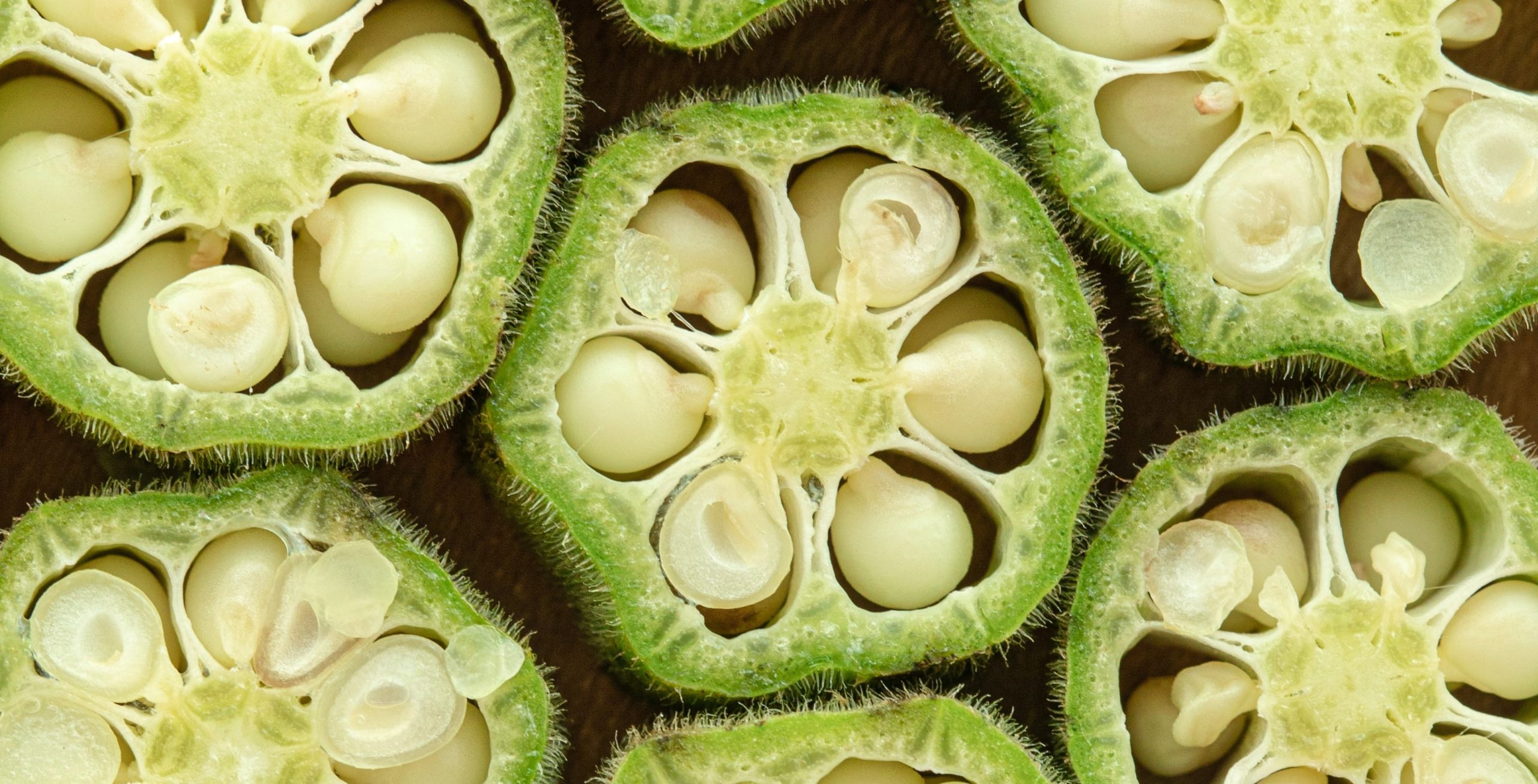Okra
Abelmoschus esculentus
Origin: Africa
Quick Facts
- ornamental flower with edible greens
- flowers come in a variety of colors
- grows well in hot Florida summer
- Swahili name is ‘mfungu’
- another fact
- another fact
- another fact

HEADING about something general
A SUBHEADING about something specific
Okra (Abelmoschus esculentus) is also called “gumbo” in Africa although the latter term is more often applied to soups or other dishes which contain okra. “Gumbo” is believed to be a corruption of a Portugese corruption, quingombo of the word quilobo, native name for the plant in the Congo and Angloa-area of Africa.
In Africa
The name Okra comes from the Igbu word, okuru. The Egyptians and Moors referred to Okra as bamya in the 12th and 13th centuries. One of the earliest documented accounts of okra in Africa is by a Spanish Moor who visited Egypt in 1216 and described the plant under cultivation by the locals who ate the tender, young pods with meal .
Nutrition Facts
Raw okra is rich in dietary fiber , vitamin C and vitamin K , with moderate amounts of thiamin, folate, and magnesium. Okra is mucilaginous , resulting in the characteristic “goo” or slime when the seed pods are cooked; the mucilage contains soluble fiber. In poor countries, Okra is used to prevent malnutrition and alleviate food insecurity.
Source USDA National Nutrient Database
(needs link)
In Your Garden
Okra is among the most heat- and drought-tolerant vegetable species in the world. Once established, it will tolerate soils with heavy clay and intermittent moisture, yet frost can damage the edible pods.
For planting, soak the seeds over night. They can be planted indoors under full light three to four weeks before the last spring frost. Otherwise, the seeds can be planted directly into the garden after the last frost and temperatures reach at least 65 degrees Fahrenheit. Seedlings require ample water, yet the plant become drought tolerant once it is established. The plant will begin continuously producing edible pods within 30 days. The pods may be green or red, and they must be harvested within one week to be edible.
Recipes for Your Table
Okra pods are available in two varieties; green and red. Red okra tastes the same as green okra, and when cooked, the red okra pods turn green. Both varieties possible way to de-slime okra is to cook it with an acidic food, such as tomatoes, to render the mucilage less viscous. Pods are cooked, pickled, eaten raw, or included in salads.
Fried Okra
Ingredients
- 10 raw okra pods
- 1 Egg, whole raw fresh
- 1 cup of cornmeal, degermed, enrich, yellow
- 1/4 teaspoon salt, table
- 1/4 teaspoon spices, pepper, black
- 1/2 cup oil, soybean, salad or cooking
Directions
In a small bowl, soak okra in egg for 5 to 10 min. In a
medium bowl, combine cornmeal, salt and pepper
Heat oil in a large skillet over medium-high heat. Dredge
okra in the cornmeal mixture, coating evenly. Carefully
place okra in hot oil stir continuously. Reduce heat to
medium when okra first starts to brown and cook until
golden brown. Drain on paper towels.

References & Resources
- The Editors. “Growing Okra: Planting, Growing, and Harvesting Okra.” The Old Farmer’s Almanac, Yankee Publishing Inc, www.almanac.com/plant/okra#. Accessed 14 Oct. 2020.
- ‘Easy Gardening: Okra. Aggie Life Extension. Texas A&M 2020
- ‘Ten Amazing Benefits of Okra’ Facty Health December 17, 2018
- Martin Anderson, Texas AgriLife Extension Service. “Okra, or ‘Gumbo, From Africa.” Aggie Horticulture, aggie-horticulture.tamu.edu/archives/parsons/publications/vegetabletravelers/okra.html. Accessed 14 Oct. 2020.
- Mossler, Mark, and Michael Aerts. “Crop Profile for Okra in Florida.” IPM Centers, 2005, ipmdata.ipmcenters.org/documents/cropprofiles/FLokra.pdf.
- Nolte, Kurt. “Okra Seed.” The University of Arizona, cals.arizona.edu/fps/sites/cals.arizona.edu.fps/files/cotw/Okra_Seed.pdf. Accessed 14 Oct. 2020.
- Tolbert, Laura. “Fleur de Lolly: Stewed Tomatoes and Okra a True Southern Classic.” Jacksonville.Com, 27 Aug. 2018, www.jacksonville.com/lifestyle/20180827/fleur-de-lolly-stewed-tomatoes-and-okra-true-southern-classic. Accessed 14 Oct. 2020
- Justin Vogt (2009-12-29). “Gumbo: The mysterious history”. The Atlantic. Retrieved 2020-10-23.
- “Definition of gumbo“. Merriam-Webster Dictionary. 2020. Retrieved 2020-10-23.
- “Many food names in English come from Africa” . VOA. 2018-02-06. Retrieved 2020-06-23.
- Stanley Dry (2020). “A short history of gumbo”. Southern Foodways Alliance. Retrieved 2020-06-13.
- ” Okra gumbo and rice” Archived 2005-10-28 at the Wayback Machine by Sheila S. Walker, The News Courier, unknown date.
- Kurt Nolte. “Okra seed” (PDF). Yuma County Cooperative Extension. Retrieved 2010-10-17.
- Martin, Franklin W. (1982). “Okra, Potential Multiple-Purpose Crop for the Temperate Zones and Tropics”. Economic Botany. 36 (3): 340–345.
This page was authored by Whitney Davis and Chloe Louidor
as part of HUM2420: African Humanities at Santa Fe College, and edited by Dr. Sarah Cervone in the Department of Humanities and Foreign Languages at Santa Fe College.
This page was created as part of a Florida Folk Life Project, a collaboration with Santa Fe College and the Matheson Historical Museum.
For more information visit www.thefloridafolklifeproject.org

